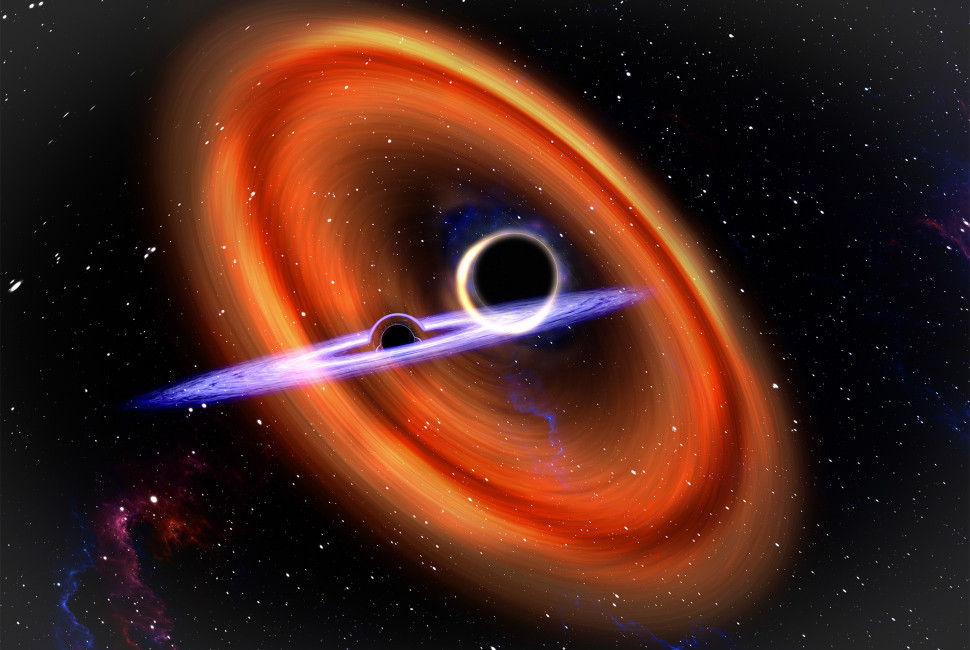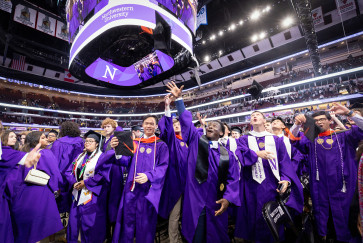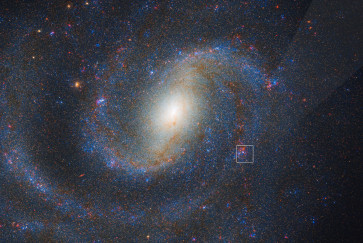A pair of distant cosmic black hole mergers is improving how scientists understand the nature and evolution of the most violent deep-space collisions in our universe.
In a new paper published Oct. 28 in The Astrophysical Journal Letters, the international LIGO-Virgo-KAGRA Collaboration reports on the detection of two gravitational wave events in October and November of last year with unusual black hole spins. The paper includes contributions from three co-authors from Northwestern’s Center for Interdisciplinary Exploration and Research in Astrophysics.
Data collected from the mergers also validates, with unprecedented accuracy, fundamental laws of physics that were predicted more than 100 years ago by Albert Einstein and furthers the search for new and still unknown elementary particles with the potential to extract energy from black holes.
Gravitational waves are “ripples” in space-time that result from cataclysmic events in deep space, with the strongest waves produced by the collision of black holes. The first merger detected, GW241011 (Oct. 11, 2024), occurred roughly 700 million light years away and resulted from the collision of two black holes weighing in at around 17 and 7 times the mass of our sun. The larger of these was measured to be one of the fastest rotating black holes observed to date.
Related: Gravitational-wave detection verifies Stephen Hawking’s theorem
Almost one month later, GW241110 (Nov. 10, 2024) was detected around 2.4 billion light years away and involved the merger of black holes roughly 16 and 8 times the mass of our sun. While most observed black holes spin in the same direction as their orbit, the primary black hole of GW241110 was noted to be spinning in a direction opposite its orbit – a first of its kind.
‘Second-generation’ black holes
The observed events sport peculiarities, including the size differential between the black holes in each merger – the larger was nearly double the size of the smaller – and the spin orientations of the larger of the black holes in each event. A natural explanation for these characteristics is that the black holes are the result of earlier mergers, pointing toward the possibility of “second-generation” black holes.
This process, called a hierarchical merger, suggests that these systems formed in dense environments, in regions like star clusters, where black holes are more likely to run into each other and merge again and again.
“The size differences of the black holes and the high spins suggest these black holes could be the products of earlier collisions,” said Shanika Galaudage, a CIERA-Adler Postdoctoral Fellow at Northwestern and paper co-author. “That points to formation in dense environments, like star clusters, where black holes can collide and merge multiple times. Each new detection helps us understand how these environments shape the black hole populations we see today.”
“These black hole mergers seem to be hinting at a more dynamic side of the universe,” she said.
Turning the universe into a precision lab
The precision of the measurements also allowed key predictions of Einstein’s theory of general relativity to be tested under extreme conditions.
Because GW241011 was detected so clearly, it can be compared to predictions from Einstein’s theory and mathematician Roy Kerr’s solution for rotating black holes. The black hole’s rapid rotation slightly deforms it, leaving a characteristic fingerprint in the gravitational waves it emits. By analyzing GW241011, the research team found excellent agreement with Kerr’s solution and verified Einstein’s prediction with unprecedented accuracy.
Additionally, because the masses of the individual black holes differ significantly, the gravitational-wave signal contains the “hum” of a higher harmonic — similar to the overtones of musical instruments — seen only for the third time ever in GW241011. One of these harmonics was observed with superb clarity and confirms another prediction from Einstein’s theory.
“These unusual, lopsided black hole mergers don’t just tell us how black holes binaries form, they turn the universe into a precision lab for Einstein’s theory,” said paper co-author Ish Gupta, an N3AS Postdoctoral Fellow at University of California, Berkeley, and visiting scholar at CIERA. “With GW241011, we achieved the strongest tests yet of key gravitational-wave features.”
Advanced search for elementary particles
Rapidly rotating black holes like those observed in this study now have yet another application: particle physics. Scientists can use them to test whether certain hypothesized light-weight elementary particles exist and how massive they are.
These particles, called ultralight bosons, are predicted by some theories that go beyond the Standard Model of particle physics, which describes and classifies all known elementary particles. If ultralight bosons exist, they can extract rotational energy from black holes. How much energy is extracted and how much the rotation of the black holes slows down over time depends on the mass of these particles, which is still unknown.
The observation that the massive black hole in the binary system that emitted GW241011 continues to rotate rapidly even millions or billions of years after it formed rules out a wide range of ultralight boson masses.
Scientists hope that as upgrades to the LIGO, Virgo and KAGRA detectors continue, more detailed observations can reveal new insights into black hole binaries and how they form.
Northwestern graduate student Darsh Bellie is also a co-author on the paper.


